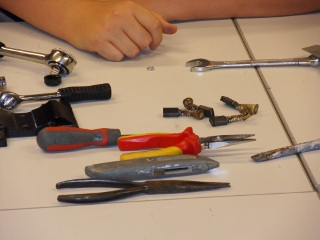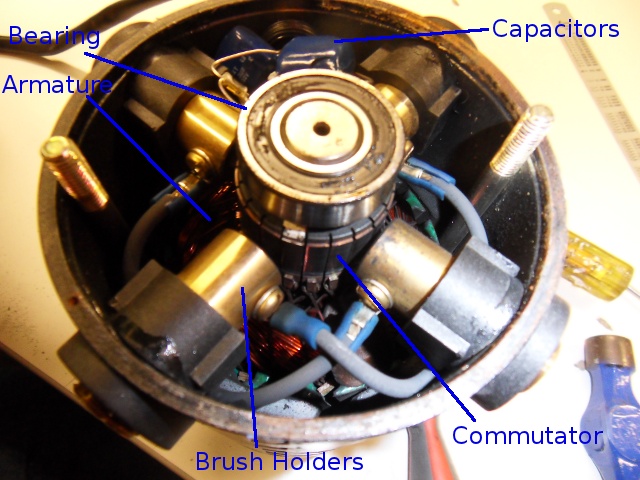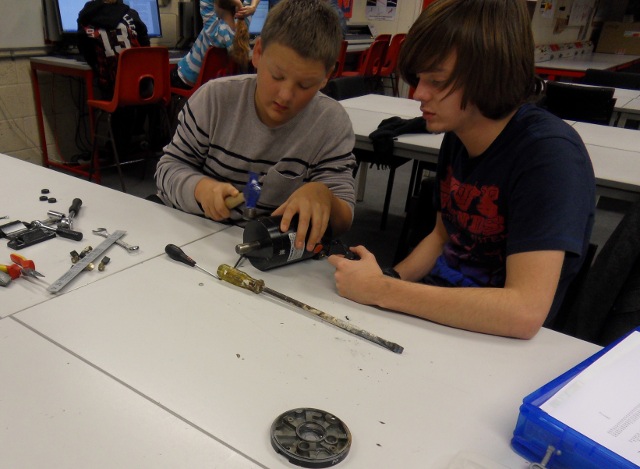Greenpower Motor Stripdown
During the Merryfield race in 2012, Rotary Racers motor had a problem. After a hard F24+ race the car was sluggish in the F24 race using more current than it should have with respect to the speed it was going. Also the motor temperature was rising much higher than it should. After the race we found that the motor was stiff to turn with a light grinding noise. If we turned it backwards there was a slight free bit and then again stiffness. We sumised that a magnet had come adrift. Considering this, it is amazing that we managed 4th in the race.
We replaced the motor for the next race. At the end of the season, we decided to strip down the motor to have a look, 3 students were set the task.
Here is the set of tools they choose to start with. There is a 10mm ? socket with ratchet, spanner (not sure what this was for ?), allen key and big screw driver. The motor braket was first removed using an allen key. Not sure why they did this, it can be left on.

Then the brushes were removed by unscrewing their caps and pulling out the brushes.

Here are the brushes. They don't seem to have worn significantly although we are unsure of the length of new brushes.

The two end nuts were unscrewed using the ratchet and 10mm ? socket. The security tabs were cut through and then they tried to lever the rear panel off with a BIG screwdriver.
On the laptop and projector screen at the back is the CAD design of Rotary Racer 9 ...

The motor plate would not lever off, so some more tools were added, followed by a hammer ! With a few "light" taps on the endplate to get it moving and with levering using a smaller screwdriver in the small gap between the case and end plate and it came away. Note the end plate has to be "pulled" from the bearing on the shaft, so it will be a little tight. Levering around the cover plate a little at a time helps.



Here is a picture inside the motor. It shows the bearing at the end of the shaft, the brush holders, armature with commutator and the supression capacitors.

Looking at the capacitors it looks like one has blown. We think high transient voltages casued by the motor speed controller switching may have caused this. Its not really a problem, but it would lead to increased electromagnetic radiation (interferance) and commutator electrical noise (spikes) that could cause problems with the Motor Speed controllers MOSFET's.

The other end panel was now removed using screwdrivers to lever and with the help of the trusty hammer to get it moving. The years race reports for the school magazine and maybe newspapers are being written at the back of this photo.

Finally the shafts end plate with armature is removed. The armature and commutator look in very good condition, no real sign of any overheating or commutator wear in the years this motor has been used. The bearings were fine as well. There was some scoring on the ouside of the armature though.

The magnets were a different story however. One of them had definitly came adrift. The picture shows the inside of the casing with 3 of the magnets still attached and the loose one removed (the magnetic attraction with the case held it roughly in place). This magnet has some scoring on it due to hitting the armature. It is suprising that the motor ran for a whole 4 hour race in this condition. I surmise that the air's centrifugal force and the odd touch to the armature was enough to keep the magnet away from the armature most of the time. It was probably offset from its correct position though, hence the reduced motor efficiency.

Although this is the first time we have had a magnet "un-glue" from the casing, it has happend to other teams especially when the motors have been overheated. We don't think that this motor has been overheated, we have logs of all races and the most it has got up to on the case is about 53 degrees C and generally it was below 40 degrees C. Its inside temperature could have been high though, especially with the higher current F24+ races the car has done this year.
One thing we did notice is that the casing where the magnet was attached was rusty. It has been a wet year, but the motor is relatively well sealed and I would have thought that the glue between the magnet and the casing would have sealed this area further.
The motor can be fixed, by simply gluing the magnet back in place with some epoxy glue. Unfortunately we won't be able to race with it as the seals have been broken, but we can use it as a generator on our motor/speed controller test rig.
Anyway there it is, the insides of a Greenpower cars motor.

